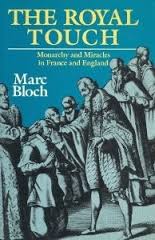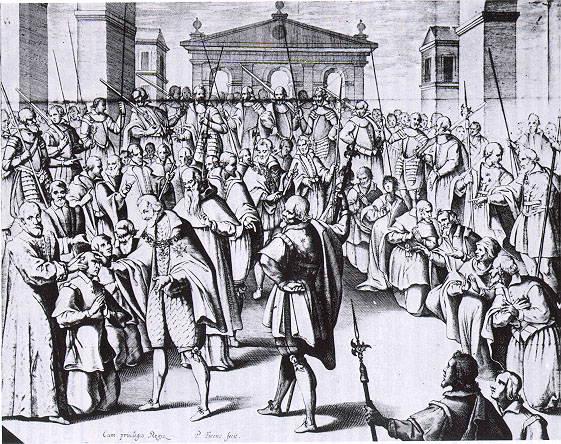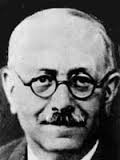This book offers a study of scrofula. Scrofula was a swelling of the glands that medical historians say was a symptom of tuberculous. It was sometimes known as the King’s Evil. What do kings have to do with glandular fever? What is a ‘royal touch?’ The reader might bear in mind the concept of charisma when reading below. A few Google images of suffers of such glandular disorders will push aside any smirks about mononucleosis. In late medieval and early Renaissance Europe tuberculous remained an insatiable serial killer.

There emerged the belief that the king’s touch could relieve the swelling. It was the King’s Evil in the sense that it an evil the king could relieve.
Why, how, and where did this conviction emerge? How did priests, abbots, monks, and popes react to the king’s intrusion into spiritual mysteries? How did word of this miracle spread? What use did king’s make of this power? Did others try to capitalise on this belief?
Bloch’s research is meticulous into original sources reaching back to the Eleventh Century to piece together something of the puzzle. Prior to the Eleventh Century there is no evidence that European kings had the healing touch. Charlemagne’s (748-814 AD) rule is well documented and much storied, but nowhere in this record is there evidence of him applying this touch. If Big Chas did not do it, it is hardly likely any lesser monarchs were at it.
With Charlemagne’s death and his Lear-like division and subdivision of his realm among his inheritors and successors, the record are fewer and less reliable as Europe fell into endless conflicts. Through these mists we can see, thanks to Bloch’s pathfinding, glimpses of the royal touch documented from the Eleventh Century and thereafter.
The healing touch of some monarchs was well enough known for the afflicted to travel great distances to seek it, and remember that travelling then usually meant walking. Nor was the king’s touch applied only to his own subjects, for these records report travellers from other realms seeking the touch of a foreign king.
The surviving reports confirm that healing effect of the king’s touch. The swelling went down. The petitioner cried out in gratitude, and so on. The doctors of spin have always been with us.
Very often for every king there were a number of pretenders and rivals with royal blood. Did they, too, have, or have the potential for, the healing touch? What is the origin of this miraculous power?
Despite its success, the evidence that remains does not suggest kings made an effort in the first instance to exploit this touch to win over adherents in any way. Rather the touch is applied only on special occasions like a patron saint’s day or the Resurrection.
By the way, the king also gave the petitioner a coin. This monetary reward might also explain why some sought the royal touch so that they could touch the royal purse as well as be touched by the royal personage.
 One such ceremony.
One such ceremony.
To some churchmen the king was intruding into religion’s domain of he supernatural with these miracles. Caesar was playing god.
How does the healing touch of a king relate to the divine right of king’s to rule? While God chose the king to rule, he himself is mortal, and has no line to divinity. That line is reserved for the ordained priesthood who sacrifice the material world. Yet later when monarchs wanted to assert their divine status, they would invoke scrofula and apply the healing touch,.e.g., Charles I of England in the Seventeenth Century.
Part of the evidence Bloch considers with his usual care is the descriptions of Charlemagne in ‘The Song of Roland.’ The poem came into European literature long after the death of Big Chas, and Bloch’s point is that it reflects the attitudes of the time of its composition, not necessarily of Charlemagne’s times. In it Charlemagne is a priest-king, giving blessings and making benedictions, wearing holy vestments as his Christian armies battle the infidel Moor. Hmm, never noticed any of that when I read ‘The Song of Roland’ as an undergraduate. But then again I missed quit a lot as an undergraduate.
Inevitably by the Fourteenth Century rival claimants to a throne and rival kings of conflicting realms sought justification in the supernatural. The healing touch was one of the fronts of these contests. But as Bloch notes, it seems that most of this conflict was in rival publicity. The kings did not have heal-offs, but their supporters circulated stories of their healing powers. Did the stories consist of whole cloth, or were they based on something? Bloch cannot be sure. What he is sure of is that they were believed by those who sought the royal touch, and the stories were credible enough for those who circulated them to continue to do so.
Churchmen, be they Protestant or Catholic, discouraged monarchs from the ritual of the touch on ecclesiastical grounds. Some of the advice was given privately and noted in diaries. Others ever so carefully denounced the practice in sermons – delivered or written. In addition religious figures involved in the upbringing of heirs-apparent indoctrinated their charges to disavow the royal touch. The most successful instance of this last indoctrination is James I of England, himself an intellectual, denounced the practice and yet did it. By the way Elizabeth I also engaged in the royal touch, laying hands on more than a thousand subjects on one occasion.
The same story unfolded in France. French kings were reluctant to do it, and were skeptical about it themselves, while they were discouraged for doing it by Catholic advisors, yet they did it.
Why?
Because their subjects wanted it. When notice was given that the king, whether in England or France, would appear at a church or cathedral to heal the sick, they came in thousands. When a reluctant king, when a king who accepted the advice of the spiritual advisors refrained from healing ceremonies, the populace became restive and the word filtered back to the royal ear that his legitimacy was in doubt. To the populace it was proof of the king’s divine right to rule that he could channel the heavens in healing.
More than one king confided to his counsellors or his day-books, the pressure he felt from this expectation, decrying the sick who gathered wherever he went, who followed his entourage into the countryside, who appeared in even the most remote location.
Those intellectuals who devised and thought out the divine right of kings, including James I himself, did not include scrofula in the equation. In fact because of the proscription of religious authorities were determined to preserve their own domination of matters spiritual. The king is chosen to rule, but that does make him divine. This fine print was of no interest to sufferers who flocked to kings for succour.
At times there were concerns about contagion and the king would not be exposed to roomfuls of plague victims. However to withhold the divine gift of the healing touch from those most in need, did not encourage loyalty in subjects. How could a divinely ordained king fear disease? Though the transmission of disease was not well understood, it was common for those with the means to do so, to leave an area when the plague occurred there. French kings travelled around the country, not to solidify their rule, but to find places without the plague. When watching one of the episodes of a television documentary on the stately house of England, say, the viewer is sometimes told that this king or queen once stayed there. That was probably a case of tourism inspired by the plague back in London.
The practice continued long into the Renaissance and even the Enlightenment. In 1715 Louis XIV, who was hesitant to lay hands on the ill, saw 1,700 in one day. Equally impressive figures survive in court records of other monarchs. None can best Charles II (1660-1684) of England in his twenty-five year reign touched nearly 100,000 of his subjects in such rituals. All the while the religious authorities looking on must have been grinding their teeth.
Kings in Austria, Spain, Bavaria, Anjou, and elsewhere claimed the healing power in pamphlets but seldom practiced it. Rival claimants for thrones began to offer to heal, once the crown went on.
All of this became entwined with other claims of divine preference. The origins of the fleur-de-lys which had been in use for generations were re-written so that it all but came down with the burning bush.
Political upheaval, Calvinist monarchs, rival faith healers, science, and the Enlightenment, these all combined to end the royal touch, as later medicine tamed tuberculous. The Hanoverians never practiced it, either in Germany or in England. The Calvinist monarchs in the low countries denied it even more vehemently. The Hapsburgs in Spain, the Netherlands, Bohemia, and Austria followed the advice of their Catholic advisors and avoided this blasphemous practice. Not even Rudolf II, that most unconventional of monarchs who dabbled in the occult, figures in the history of the royal touch.
The king’s touch was at its most potent when his accession to the purple was consecrated in a religious service, at Westminster for Brits and at Rheims for French. For in the beliefs of the day when the priest blessed the new king for a moment God’s will was manifest in the flesh. Talk about charisma! On those widely publicised occasions veritable armies of diseased petitioners would show up, along with the rich and mighty of the land.
Such records as there are show that some sufferers came repeatedly for the royal touch, plain proof that it had not worked the first time, the second time, or the third time. Some observers took the view that many of the ill came for the coin not the touch. Others, still more cynical, said that the petitioners were petty criminals who used the occasions as a pretext for pickpocketing and worse. Contemporary scientists, including some on the occult side of the table, tried without success to find an explanation for the effectiveness of the touch. Some physicians who were empirically minded kept track of those who had received the royal touch, and found… they died. The data was held in secret.
Yet the demand for the practice continued until monarchs were discredited and destroyed by political revolutions. Though Bloch is slow to accept it, the final explanation seems to be some kind of collective wish fulfilment, though that wording is more Freudian than his, which takes it to be an expression of a collectively unconscious need to assert control over the inexplicable and unknown, or even unknowable.
The book is 220-pages of text accompanied by another 220-pages of notes, appendices, descriptions of iconography, and citations. He wears the research lightly but it is impressive.
Marc Bloch wrote many fine books, including the magisterial ‘Feudal Society’ (1939) in two volumes which I read in 1974. It was one of the great books I relinquished when I moved from the Merewether Building.
 Marc Bloch, who murdered in Paris in 1944.
Marc Bloch, who murdered in Paris in 1944.
My main source of medieval history is, of course, Robin Hood on television in 144 episodes from 1955-1960. This Robin Hood was the dashing and charming Richard Greene. I now realise a very young Paul Eddington was Will Scarlett in this series.
Postscript
Is the royal meet-and-greet when the queen, king, or prince(ss) walks through a crowd some vestigial echo of scrofula. People line up for hours for a glimpse of the anointed one, and the fortunate few in the front ranks may even still today with maxed security get a royal touch. Do those so touched feel better, elated, special, or something? They must, or to be more specific, they must think beforehand that they will, and so invest the time, energy, and effort to get that position in the hope of being touched.
It all fits with Max Weber’s conception the charismatic as one carrying a special grace, and the appetite of others to share in it by proximity or adherence.
Skip to content
